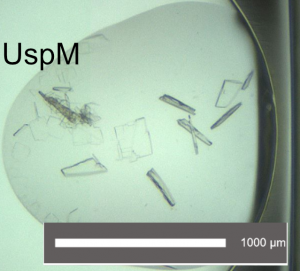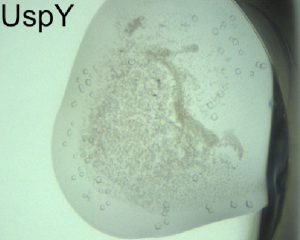Universal stress proteins
UspM and UspY crystals that can be optimised to gain high resolution data
Supervisor: Dr. Fellner (Biochemistry) & Dr. Pletzer (Microbiology and Immunology)
The USPs projects are in collaboration with the Pletzer Lab – University of Otago – Department of Microbiology and Immunology. Co-supervision between the Fellner Biochemistry and Pletzer Microbilogy Department will strengthen these projects.
Summary: This project is ideal if you want work on a project that links Biochemistry and Microbilogy, be exposed to both areas of research into infectious diseases. Here you will be the first in the world to determine the structure of a protein. UspM, UspN, UspK, UspX and UspY have successfully been purified in the past, showing a great potential for protein crystallisation, with crystals available for UspM and UspY but their structures have not been determined yet. A student project will focus on 1-3 USPs depending on degree level. In addition, the following techniques will investigate the oligomeric structure and potential to bind nucleotides:
- Isothermal titration calorimetry and Circular dichroism: Nucleotide binding preference/strength.
- Small-angle X-ray scattering: In solution structure of oligomeric state with nucleotides.
- X-ray crystallography: Atomic information of oligomer interfaces and nucleotide binding.
- Pull-down assay combined with mass spectrometry: USPs bound by nucleotide will be immobilised on resin; exposed to Pa proteome; interactions revealed by mass spectrometry
- Bacterial growth studies: Combined with mass spectrometry metabolomics; link nucleotides to USPs during bacterial growth



